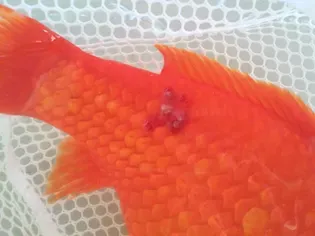Flashing in Aquarium Fish
Updated on 04/26/24

Shining Radiance: Unraveling the Enigmatic Phenomenon of Flashing in Aquarium Fish
In the vibrant tapestry of an aquarium, flashing stands out as an enigmatic behavior that captivates both aquarists and marine biologists alike. This sudden, erratic swimming pattern, characterized by rapid darting or twitching movements, often accompanied by rubbing against objects, has bewildered and fascinated observers for centuries. While seemingly innocuous, flashing can signal underlying health issues, making it crucial for aquarists to understand the potential causes and appropriate remedies.
Delving into the Depths of Flashing Behavior in Aquarium Fish
Flashing is a complex behavior that can manifest itself in various forms. Some fish may exhibit brief, sporadic flashes, while others engage in prolonged rubbing and scraping against the substrate or aquarium walls. The severity and frequency of flashing often depend on the underlying cause.
Understanding the Causes of Flashing in Aquarium Fish
Flashing is a symptom rather than a disease itself. It can arise from a multitude of factors, including:
1. Parasitic Infestations:
Parasites, such as ich (white spot disease) and flukes, can cause intense irritation and itchiness, leading to frequent flashing as the fish attempt to dislodge the parasites.
2. Bacterial Infections:
Bacterial infections, such as fin rot and body slime, can cause lesions, ulcers, and inflammation, which can trigger flashing behavior as the fish try to soothe the affected areas.
3. Water Quality Issues:
Poor water quality, including elevated levels of ammonia, nitrite, or nitrate, can irritate the fish's skin and gills, resulting in flashing.
4. Stress:
Stressful conditions, such as overcrowding, inadequate filtration, or incompatible tankmates, can weaken the fish's immune system and make them more susceptible to flashing behavior.
5. Mechanical Injuries:
Physical injuries, such as cuts or abrasions, can also cause flashing as the fish attempt to clean and disinfect the wound.
6. Nutritional Deficiencies:
Inadequate nutrition, particularly a lack of vitamins and minerals, can weaken the fish's immune system and make them more prone to flashing.
7. Allergic Reactions:
Some fish may experience allergic reactions to certain substances in their environment, such as medications or cleaning products, which can trigger flashing behavior.
Distinguishing between Normal and Abnormal Flashing
While flashing is often associated with health issues, it's important to note that some species of fish may exhibit occasional flashing as a normal behavior. For instance, some cichlids and loaches engage in flashing to remove excess mucus or establish dominance. However, persistent, frequent, or erratic flashing accompanied by other symptoms, such as lethargy, loss of appetite, or visible lesions, warrants closer investigation.
Effective Remedies for Flashing in Aquarium Fish
Addressing the underlying cause of flashing is essential for effective treatment. The appropriate remedy will vary depending on the specific cause:
1. Parasitic Infestations:
Treatment involves using medication specifically designed to eradicate the parasite. Follow the manufacturer's instructions carefully regarding dosage and treatment duration.
2. Bacterial Infections:
Antibiotic medications are typically used to combat bacterial infections. Ensure the medication is compatible with the fish species and administer it according to the prescribed dosage.
3. Water Quality Issues:
Conduct regular water changes to improve water quality. Address any underlying filtration or water chemistry issues.
4. Stress:
Identify and address any sources of stress in the tank, such as overcrowding, inadequate filtration, or incompatible tankmates.
5. Mechanical Injuries:
Treat any wounds promptly with antiseptic solutions and provide a clean, stress-free environment for the fish to recover.
6. Nutritional Deficiencies:
Ensure the fish are receiving a balanced diet that meets their nutritional requirements. Consider supplementing their diet with vitamins and minerals as needed.
7. Allergic Reactions:
Remove any potential allergens from the aquarium and consult with a veterinarian to determine the cause of the allergy.
Conclusion
Flashing behavior in aquarium fish is a complex phenomenon with a wide range of potential causes. Understanding the underlying etiology is crucial for determining the most appropriate treatment. By addressing the underlying health issues, providing a clean and stress-free environment, and administering appropriate medications when necessary, aquarists can effectively combat flashing and ensure the well-being of their prized aquatic companions. Remember, observing and promptly addressing any unusual behaviors in aquarium fish is essential for maintaining a healthy and thriving aquatic ecosystem.
Explore More Pets

Freshwater Aquarium Filters
How to Deal With Cloudy Aquarium Water

Saltwater Aquarium Filters
How Do You Remove Chloramines From Tap Water?

Freshwater Aquariums & Habitat
Can I Keep My Koi Fish Inside?

Saltwater Aquariums & Habitat
14 Best Floating Plants for Your Aquarium

Freshwater Fish Health
How to Treat Ich on Freshwater Fish

Saltwater Fish Health
Fin Rot in Aquarium Fish

Freshwater Aquarium Filters
How to Do Aquarium Water Changes

Saltwater Fish Health
How Do Fish Get Parasites?